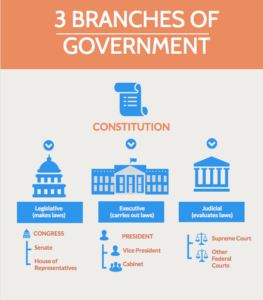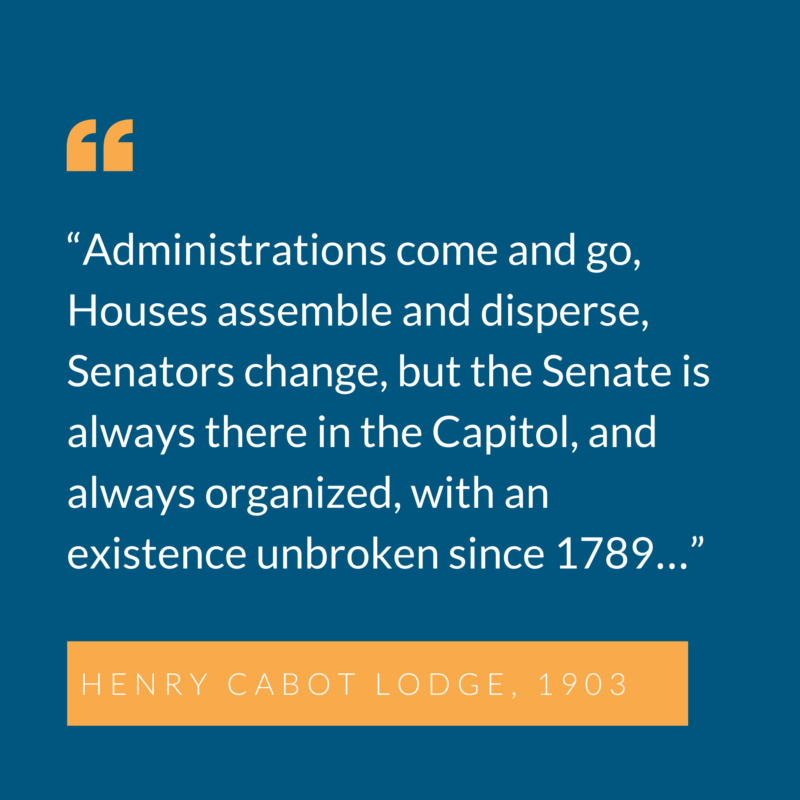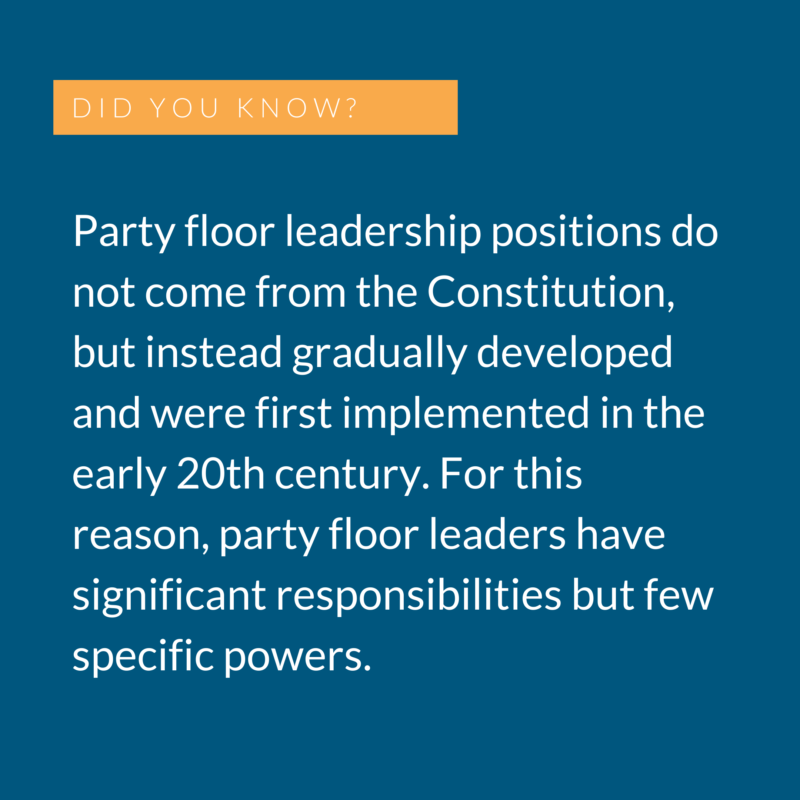Introduction
View the Executive Summary for this brief.
The United States spent eight long years of desperate fighting for independence from 1775 to 1783. By 1789, the Founding Fathers had set about constructing a government “built on the cardinal conviction of revolutionary-era republicanism: that no central authority empowered to coerce or discipline the citizenry was permissible, since it merely duplicated the monarchical and aristocratic principles that the American Revolution had been fought to escape. The United States is now the oldest enduring republic in world history, with a set of political institutions and traditions that have stood the test of time.”
According to House.gov, “To ensure a separation of powers, the U.S. Federal Government is made up of three branches: legislative, executive and judicial. To ensure the government is effective and citizens’ rights are protected, each branch has its own powers and responsibilities, including working with the other branches.” This is often referred to as “checks and balances,” and prevents any one part of government from wielding too much political power.
Why it Matters
America benefits from a judicial branch positioned to halt executive branch overreach. The President of the United States cannot stay in power indefinitely and is unable to force the U.S. Congress to pass laws. From the very beginning, and still to today, the American people have access to and influence over their elected representatives.
The House of Representatives tends to reflect popular passions and passing enthusiasms, while the Senate is expected to provide advice and consent on presidential appointments and treaties and to temper enthusiasm with wisdom and experience. Together they form Congress, the legislative branch of our federal government. Understanding the structure of our government is essential to understanding how policy translates into law. The policy choices our legislators make can shape the direction of our country.
In serving the people, the Senate works at its own pace and sometimes in conflict with the other branches of government. In this brief we will look at the U.S. Senate, its structure, its unique role in government and what you can do to influence your senator in the legislative process. For a brief on the U.S. House of Representatives, click here.
What is the Legislative Branch?
 The Senate and House of Representatives comprise the United States Congress, which serves as the legislative branch of our government and is based in The Capitol in Washington D.C. Among other powers, the legislative branch “makes all laws, declares war, regulates interstate and foreign commerce and controls taxing and spending policies.”
The Senate and House of Representatives comprise the United States Congress, which serves as the legislative branch of our government and is based in The Capitol in Washington D.C. Among other powers, the legislative branch “makes all laws, declares war, regulates interstate and foreign commerce and controls taxing and spending policies.”
Through the “Great Compromise” of July 16, 1787, it was decided that House seats would be apportioned by population and directly elected by the people, and that each state would have at least one representative. The Senate would be composed of two senators from each state elected by the state legislatures and thus indirectly by the people; in 1913, that changed so that senators would be directly elected by the people of each state.
Congress carries the “power of the purse,” which is the ability to tax and spend public money for the national government. But it also means that Congress can block activity by refusing to authorize public funding for an agency, program or entity. The Senate in particular was designed to serve as a counterbalance to the House of Representatives and as a brake on executive power from the president.
CrashCourse U.S. Government and Politics, produced in collaboration with PBS, explains the Bicameral Congress (9 min):
Size and Structure of the Senate
There are two senators from each state serving in Congress. Small and large states alike each have two Senators, so there is no differentiation in representation based on population, unlike the House, and there are fewer senators (100) compared to representatives in the House (435).
Elections
Senators were originally chosen by state legislatures, but that process began to break down in the 1850s. “Intimidation and bribery marked some of the states’ selection of senators,” with forty-five deadlocks in twenty states between 1891 and 1905. In 1899, in fact, “problems in electing a senator in Delaware were so acute that the state legislature did not send a senator to Washington for four years.” In order to “remove control of government from the influence of special interests and corrupt state legislators,” reform came with the 17th Amendment to the Constitution in 1913, which provided for the direct popular election of Senators.
A senator must be at least 30 years old, a citizen of the United States for at least nine years, and a resident of the state they represent.
 Senators are elected to six-year terms. The idea for a six-year term “represented a compromise between those constitutional framers who wanted a strong, independent Senate and those who feared the possible tyranny of an aristocratic upper house, insulated from popular opinion.” In an endeavor to provide both continuity and rotation, the terms are staggered in the Senate, with one-third of the Senate’s members facing reelection every two years. According to Constitutional commentator Joseph Story, the framers hoped “biennial elections would bring stability to the Senate,” and that, “as the federal government’s only continuing body, the Senate could provide leadership after major elections and during other periods of national uncertainty.”
Senators are elected to six-year terms. The idea for a six-year term “represented a compromise between those constitutional framers who wanted a strong, independent Senate and those who feared the possible tyranny of an aristocratic upper house, insulated from popular opinion.” In an endeavor to provide both continuity and rotation, the terms are staggered in the Senate, with one-third of the Senate’s members facing reelection every two years. According to Constitutional commentator Joseph Story, the framers hoped “biennial elections would bring stability to the Senate,” and that, “as the federal government’s only continuing body, the Senate could provide leadership after major elections and during other periods of national uncertainty.”
Life of a Senator
A senator generally carries more power than the average individual member of the House because a senator represents an entire state while a House member represents only one district within a state. In representing an entire state, a senator is in most cases responsible for more constituents than a House Representative – except in the states where Senators outnumber House Representatives, as is the case in Alaska, Delaware, Montana, North Dakota, South Dakota, Vermont and Wyoming, with each having one representative. Also because there are fewer of them, senators carry a larger megaphone to bring attention to a particular issue.
The day-to-day activities of a senator are not entirely different from a House representative. They spend their days meeting with constituents, discussing policy issues in committee meetings and making public appearances to convey their message to the public. The House of Representatives passes legislation more frequently than the more deliberative Senate, so senators spend less time voting on the Senate floor and more time negotiating compromises before a bill reaches the Senate floor for a vote.
What Does the Senate Do?
The framers originally created the Senate “to protect the rights of individual states and safeguard minority opinion in a system of government designed to give greater power to the national government.”
Responsibilities of the Senate
The Senate has two important and specific duties. Senators are empowered to conduct impeachment proceedings of high federal officials, are tasked with exercising the power of advice and consent on treaties, and play an important role in the confirmation (or denial) of certain appointments including ambassadors and judicial court justices.
Impeaching High Officials
Article I, section 3, clause 6 of the Constitution explains, “The Senate shall have the sole power to try all Impeachments… And no Person shall be convicted without the Concurrence of two thirds of the Members present.”
The Senate presides over impeachments of the president or other high officials and can remove them by a two-thirds vote. An official is impeached once the House votes to approve an article of impeachment. The House then sends an indictment – the articles of impeachment – to the Senate, which forms itself into a jury.
If the official accused is below the level of the president, the vice president acts as the presiding officer of the impeachment. But if the official being impeached is the president, the chief justice of the Supreme Court presides over the Senate proceedings.
The Senate could vote to acquit the accused official, but if two-thirds of the Senate finds the official guilty, that official is removed from office and then subject to the regular penalties of law.
Providing Advice and Consent
Article II, section 2, clause 2 of the Constitution says, “[The president] shall nominate, and by and with the Advice and Consent of the Senate, shall appoint Ambassadors, other public Ministers and Consuls, Judges of the supreme Court, and all other Officers of the United States.” Senators have this unique role based on the idea that “senators as statewide officials ‘would be uniquely qualified to identify suitable candidates’.” The particular duty came about as a compromise between the framers who wanted the President to have the sole power of appointment and those who wanted the power to reside with the Senate.
Article II, section 2, clause 2 also says the president “shall have Powers, by and with the Advice and Consent of the Senate, to make Treaties, provided two thirds of the Senators present concur.” Originally, the Continental Congress dispatched agents to negotiate treaties, which could only be approved if nine of the thirteen states consented. The individualized nature of the process, complicated by the fact that states also had the ability to enter into treaties themselves, made that particular system inefficient.
Leadership in the Senate
Vice President
The vice president is designated as the “‘ex-officio President of the Senate.’” The vice president has a “constitutional duty” to “preside over the Senate,” although the vice president cannot vote in the Senate (except to break a tie) or formally address the Senate without the senators’ permission. “To secure definitive resolutions, the Senate’s president must be able to cast tie-breaking votes, yet be denied a vote at all other times. Therefore, the Senate’s presiding officer must not be a member of the Senate,” explains Senate.gov’s interpretation of Alexander Hamilton’s The Federalist, No. 68.
From John Adams in 1789 to Richard Nixon in the 1950s, presiding over the Senate was the chief function of vice presidents, who had an office in the Capitol, received their staff support and office expenses through the legislative appropriations, and rarely were invited to participate in cabinet meetings or other executive activities. In 1961, Vice President Lyndon B. Johnson changed the vice presidency by moving his chief office from the Capitol to the White House, by directing his attention to executive functions, and by attending Senate sessions only at critical times when his vote, or ruling from the chair, might be necessary. Vice presidents since Johnson’s time have followed his example.
President Pro Tempore
The “president pro tempore” presides over the Senate in absence of the vice president and is third in the line of succession to the presidency, behind the vice president and Speaker of the House. The Senate elects one senate member to serve as president pro tempore.
Majority & Minority Leadership
The political party with over 50% of the Senate seats holds the majority and is therefore empowered to fill the position of senate majority leader. The majority leader is elected by members of his/her party and serves as a spokesperson for the party’s positions on relevant issues, and is often considered the spokesperson for the Senate as well. The “right of first recognition” enables the majority leader to speak before any other senator regarding a piece of legislation. It is also the majority leader’s responsibility to work with committee chairs and ranking members to schedule the daily legislative floor agenda.
The minority party, with fewer than 50% of the Senate seats, also has a minority leader position. Similar to the majority leader, the minority leader represents his/her party on the Senate floor, but does not have the right of first recognition or the ability to set the floor agenda. The minority leader and majority are meant to consult one another to come to agreements on floor debate rules and to equally divide debate time between the parties.
Other important positions for both the majority and minority parties include:
- Party Whips, who are assistant leaders responsible for “rounding up party members for votes and quorum calls,” as well as for sometimes standing in for their majority or minority leaders in the case of their absence.
- Conference Chairpersons preside over closed sessions known as party conferences (or party caucuses), during which members of each party meet to elect floor leaders, determine committee assignments, and set legislative agendas. The Democratic floor leader serves as his/her party’s chair, while the Republican Party elects a chairperson that is not the floor leader.
- Policy Committee Chairs serve as leaders of their respective party’s policy committees. The Republican and Democratic Senate policy committees were created in 1947 “to achieve policy integration and to promote party unity through the dissemination of information about policy and other Senate matters.” Each serves as “an analytical arm of its respective party leadership” and provides analysis of policy issues, solutions, and alternatives, as well as a forum for policy discussions.
The Role of Committees
Like the House, the Senate has committees that study issues in depth. Committee membership “enables members to develop specialized knowledge of the matters under their jurisdiction.” The role of committees is to “monitor on-going governmental operations, identify issues suitable for legislative review, gather and evaluate information, and recommend courses of action” to the Senate as a whole.
Before the start of each new Congress, party conferences convene to determine committee assignments based on the party’s allotted committee seats. In the Senate there are three types of committees: standing committees, which are permanent bodies with specific responsibilities and jurisdictions; special/select committees, which have a clearly specified purpose and often expire after submitting a final report; and joint committees with the House of Representatives, which “perform housekeeping functions or conduct studies.” There are 16 standing committees, 4 special/select committees, and 4 joint committees.
There are a few restrictions on committee membership, which are intended to treat senators equitably in the assignment process. First, when a state is represented by two senators from the same party, they may not serve together on the same committee. Additionally, each senator is limited to service on two of the “A” committees, and one of the “B” committees. Service on “C” committees is unrestricted.
More prestigious committees (“A” committees) are generally more powerful (and are therefore an advantageous platform for potential political fundraising). For example, a senator that serves on the Appropriations Committee has more power over what programs get what level of funding.
For a full list of committees and their classifications, see this Congressional Research Service report.
Legislation in the Senate
During the course of each two-year congressional session, the Senate will refer approximately 3,000 bills and resolutions to its committees. Committees act on a small proportion of these, as some are only meant to call attention to issues or test future support. Approximately 500 bills and resolutions are reported to the full Senate.
Committee Process
Once a bill is introduced, it is assigned to one of the Senate’s standing committees by the Senate Parliamentarian. The Senate committee studies the bill and summons numerous witnesses to hearings on the bill, including members of Congress, administrative officials, representatives from the business sector, and the general public. After hearings, the committee “marks-up” the bill, meaning the members debate, modify, and ultimately vote for or against the bill (similar to the House committees). Once released from the committee, the bill goes to the Senate floor for consideration.
Floor Debate
Unlike in the House, bills in the Senate are not subject to the same type of parameters set by the House Committee on Rules. The Senate does not have a rules committee like the House Rules Committee that exists to manage floor procedures because the Senate was meant to have a more open, deliberative method of exploring policies, which allow senators to offer amendments that have no relation to the underlying bill. This makes the Senate almost a leaderless body in the sense that any senator can take control of the agenda by offering an amendment and then force a debate on that amendment. As a result, it can be very difficult to get a bill passed in the Senate. For example, if most Republicans and Democrats want to pass a transportation bill, but one senator is against the bill, that one senator can bring up an amendment on a divisive issue (e.g., gun control) that ends up killing the underlying bill.
During a typical floor debate on an individual piece of legislation, every senator is given the opportunity to speak for or against a bill, and each has the right to unlimited debate. To ensure legislation continues to move in a timely fashion, the Senate works out unanimous consent agreements that set parameters around debates. Non-controversial bills can also be “hotlined,” meaning the majority and minority leaders – after consulting with their Senate colleagues – agree to pass the legislation by unanimous consent and without a roll-call vote in order to save time by moving legislation more quickly.
Motion to Proceed
The Senate must first agree to consider a piece of legislation by voting on a motion to proceed, which requires 60 votes. The Senate majority leader attempts to get all senators to agree by unanimous consent to take up the bill he wishes to have debated. If senators withhold their consent, they are implicitly threatening extended debate on the question of considering the bill. Senators may do this because they oppose the bill or because they wish to delay consideration of one measure in the bill in the hope of influencing the fate of some other, possibly unrelated, measure. Senators can also place a hold on a bill, by which they ask their party’s floor leader to object on their behalf to any unanimous consent request to consider the bill, at least until they have been consulted.
Filibuster
A filibuster is a method of extending debate by introducing extraneous or unrelated issues to a legislation, an appointment or other issue that the Senate is debating.
The idea behind the filibuster was that “unlimited debate continued on the grounds that any senator should have the right to speak as long as necessary on any issues.” As long as a senator kept talking on the floor, a bill could not move forward. Throughout the 19th century, the Senate left ending the filibuster up to the filibustering senators. When they felt they had been adequately heard, they could give up the floor and allow debate to move on to a vote.
 During World War I, one measure related to war in Europe “tied the Senate up for 33 days and blocked passage of three major appropriations bills,” prompting President Woodrow Wilson to act. At his urging, senators adopted Rule 22 in 1917, which “allowed the Senate to end a debate with a two-thirds majority vote, a device known as ‘cloture’.” Since 1975, the cloture motion only needs to be adopted by three-fifths of the Senate (60 votes), after which debate can only continue for a maximum of 30 additional hours before the Senate needs to vote on the matter (only a simple majority is needed to pass the bill). Important exceptions to the filibuster rule include nominations to executive branch positions and federal judgeships, which only require a simply majority rather than three-fifths to end debate.
During World War I, one measure related to war in Europe “tied the Senate up for 33 days and blocked passage of three major appropriations bills,” prompting President Woodrow Wilson to act. At his urging, senators adopted Rule 22 in 1917, which “allowed the Senate to end a debate with a two-thirds majority vote, a device known as ‘cloture’.” Since 1975, the cloture motion only needs to be adopted by three-fifths of the Senate (60 votes), after which debate can only continue for a maximum of 30 additional hours before the Senate needs to vote on the matter (only a simple majority is needed to pass the bill). Important exceptions to the filibuster rule include nominations to executive branch positions and federal judgeships, which only require a simply majority rather than three-fifths to end debate.
There is a debate over the filibuster. One side argues it is not needed because our Founding Fathers structured the Senate in such a way that the minority view is protected. Others disagree, saying the filibuster is required to protect the minority.
The Federalist Society explains the filibuster further (4 min):
Conference Committee
When the Senate and House pass the same bill with different policy language, the differences are worked out in a conference committee. A conference committee is a temporary committee made up of members from both the Senate and the House who work together to come to a consensus about the different provisions in the bill. Each chamber then has to approve the final compromise legislative text and it is then sent to the President to be signed into law.
Once sent, the president has ten days to sign or veto the bill. If the president vetoes the bill, it can still become a law if two-thirds of the Senate and two-thirds of the House then vote in favor of the bill.
Khan Academy dives deeper into the Senate (6 min):
Additional Resources
Ways to Get Involved/What You Can Do
Measure & Identify: Who influences policy that affects your state, county, or community? Learn about their priorities and consider how to contact them.
- Do you know who your Senator is? Find out who they are and what committee(s) they serve on.
- Find out what bills your senators have sponsored, and track their votes with GovTrack.
Reach out: You are a catalyst. Finding a common cause is a great opportunity to develop relationships with people who may be outside of your immediate network. All it takes is a small team of two or three people to set a path for real improvement. The Policy Circle is your platform to convene with experts you want to hear from.
- Find allies in your community or in nearby towns and elsewhere in the state.
- Foster collaborative relationships with colleagues, neighbors, friends, and local organizations to mobilize an effort to bring attention to your issue to your local Congressional office. Also reach out to community leaders to educate them and request their engagement on the issue.
Plan: Set some milestones based on your state’s legislative calendar.
- You can find the legislative calendar for the Senate here.
- Don’t hesitate to contact The Policy Circle team, communications@thepolicycircle.org, for connections to the broader network, advice, insights on how to build rapport with policy makers and establish yourself as a civic leader.
Execute: Give it your best shot. You can:
- Research: Make sure you know the facts about the issue you are raising. Government agencies, think tanks, and media outlets can all be good resources. Remember to research all sides of the issue to make sure you understand various angles. You can also talk with people who are affected by the issue with which you are concerned; anecdotal information combined with measured data can be powerful.
- Write: Although we may be more inclined to email in the digital age, writing an old-fashioned letter to your local elected representatives or to members of Congress is still one of the most effective ways to influence lawmakers.
- See these tips for step-by-step instructions to write letters to elected officials, including how to address your representative, reference specific legislation, and properly send your correspondence.
- See these tips on how to make an appointment with your senator or their staff, and what to expect and how to prepare.
- Organize: Organize people to call in, follow-up on written material, and reach out to other community members to educate them on the issue. Demonstrating wide support can be very effective in influencing a legislator to support your position.
Working with others, you may create something great for your community. Here are some tools to learn how to contact your representatives and write an op-ed.
Suggestions for your Next Conversation
Explore the Series
This brief is part of a series of recommended conversations designed for circle's wishing to pursue a specific focus for the year. Each series recommends "5" briefs to provide a year of conversations.